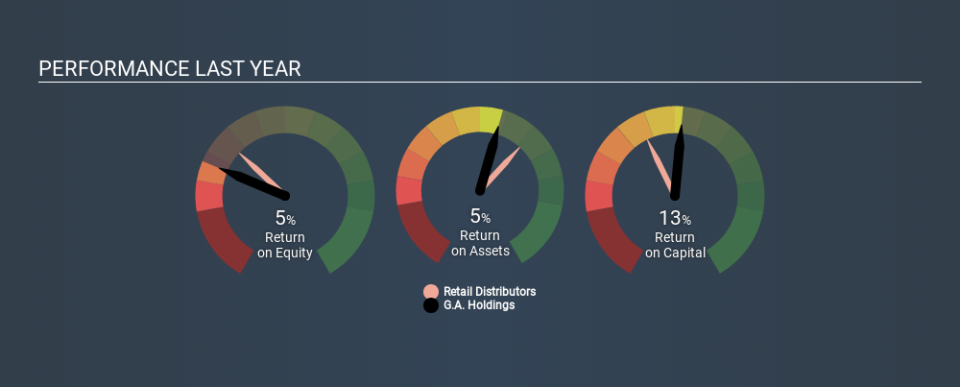G.A. Holdings Limited (HKG:8126) Is Employing Capital Very Effectively

Today we'll look at G.A. Holdings Limited (HKG:8126) and reflect on its potential as an investment. To be precise, we'll consider its Return On Capital Employed (ROCE), as that will inform our view of the quality of the business.
First of all, we'll work out how to calculate ROCE. Then we'll compare its ROCE to similar companies. Finally, we'll look at how its current liabilities affect its ROCE.
Understanding Return On Capital Employed (ROCE)
ROCE measures the amount of pre-tax profits a company can generate from the capital employed in its business. All else being equal, a better business will have a higher ROCE. Overall, it is a valuable metric that has its flaws. Author Edwin Whiting says to be careful when comparing the ROCE of different businesses, since 'No two businesses are exactly alike.
How Do You Calculate Return On Capital Employed?
Analysts use this formula to calculate return on capital employed:
Return on Capital Employed = Earnings Before Interest and Tax (EBIT) ÷ (Total Assets - Current Liabilities)
Or for G.A. Holdings:
0.13 = HK$93m ÷ (HK$1.5b - HK$782m) (Based on the trailing twelve months to September 2019.)
So, G.A. Holdings has an ROCE of 13%.
See our latest analysis for G.A. Holdings
Does G.A. Holdings Have A Good ROCE?
When making comparisons between similar businesses, investors may find ROCE useful. In our analysis, G.A. Holdings's ROCE is meaningfully higher than the 9.1% average in the Retail Distributors industry. We consider this a positive sign, because it suggests it uses capital more efficiently than similar companies. Regardless of where G.A. Holdings sits next to its industry, its ROCE in absolute terms appears satisfactory, and this company could be worth a closer look.
We can see that, G.A. Holdings currently has an ROCE of 13% compared to its ROCE 3 years ago, which was 8.9%. This makes us think the business might be improving. You can see in the image below how G.A. Holdings's ROCE compares to its industry. Click to see more on past growth.
Remember that this metric is backwards looking - it shows what has happened in the past, and does not accurately predict the future. ROCE can be misleading for companies in cyclical industries, with returns looking impressive during the boom times, but very weak during the busts. This is because ROCE only looks at one year, instead of considering returns across a whole cycle. If G.A. Holdings is cyclical, it could make sense to check out this free graph of past earnings, revenue and cash flow.
How G.A. Holdings's Current Liabilities Impact Its ROCE
Short term (or current) liabilities, are things like supplier invoices, overdrafts, or tax bills that need to be paid within 12 months. The ROCE equation subtracts current liabilities from capital employed, so a company with a lot of current liabilities appears to have less capital employed, and a higher ROCE than otherwise. To counteract this, we check if a company has high current liabilities, relative to its total assets.
G.A. Holdings has total assets of HK$1.5b and current liabilities of HK$782m. Therefore its current liabilities are equivalent to approximately 52% of its total assets. This is admittedly a high level of current liabilities, improving ROCE substantially.
The Bottom Line On G.A. Holdings's ROCE
While its ROCE looks decent, it wouldn't look so good if it reduced current liabilities. G.A. Holdings looks strong on this analysis, but there are plenty of other companies that could be a good opportunity . Here is a free list of companies growing earnings rapidly.
For those who like to find winning investments this free list of growing companies with recent insider purchasing, could be just the ticket.
If you spot an error that warrants correction, please contact the editor at editorial-team@simplywallst.com. This article by Simply Wall St is general in nature. It does not constitute a recommendation to buy or sell any stock, and does not take account of your objectives, or your financial situation. Simply Wall St has no position in the stocks mentioned.
We aim to bring you long-term focused research analysis driven by fundamental data. Note that our analysis may not factor in the latest price-sensitive company announcements or qualitative material. Thank you for reading.

